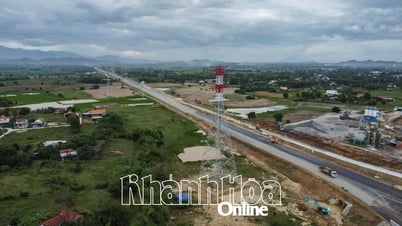This was raised by Dr. Dang Minh Tan, University of Transport, at the Vietnam Traffic Safety Conference 2023 organized by the National Traffic Safety Committee on the morning of October 12.
Dr. Dang Minh Tan said that by the end of 2023, it is expected that a total of 1,852km of expressways will be in operation nationwide. However, there are still many problems in management, operation and exploitation combined with the problem of low awareness of traffic participants, which is not suitable for participating in traffic on expressways. This leads to the situation where vehicles drive slowly, occupying the left lane close to the median strip, leading to fast vehicles that need to overtake having to overtake on the right or a mixture, causing many traffic conflicts, increasing the risk of traffic jams and accidents.
Dr. Dang Minh Tan pointed out that in many countries around the world, the use of lanes by vehicles on highways is clearly regulated and managed. For example, in the US, most states have laws requiring vehicles to stay in the right lane or yielding laws requiring vehicles to stay in the right lane or to change lanes to the right to give way to vehicles that want to overtake from behind.
Similarly, in Germany, according to road traffic law, vehicles must stay in the right lane. The left lane is only used for overtaking, except in special cases (e.g. traffic jams, accidents).
Meanwhile, according to Dr. Dang Minh Tan: "In Vietnam, the regulations and sanctions on lane use for different types of vehicles on highways are not really complete and clear. Not only on highways but also on many normal car routes, most drivers want to "occupy" the left lane close to the median strip even when driving at very slow speeds."
He cited the results of a survey and analysis on three important, typical expressways in the Northern region (Phap Van - Cau Gie, Lang - Hoa Lac and Hanoi - Thai Nguyen) showing that most vehicles choose the left lane (lane number 1) for roads with 4 lanes and lanes number 1 and 2 for roads with 6 lanes.
Of these, only 42.62% of trucks chose the rightmost lane (No. 2) on the Hanoi - Thai Nguyen highway, 37.15% chose the rightmost lane (No. 3) on the Phap Van - Cau Gie highway and 28.86% chose the rightmost lane (No. 3) on the Lang - Hoa Lac highway. Vehicles traveling at speeds lower than 60km/h accounted for a high proportion.
"In particular, many vehicles travel at speeds below 40km/h in lane 1, forcing vehicles to pass on the right," he said. The study also showed that cars and buses tend to travel at higher speeds than trucks, but many cars still travel at very low speeds in lane 1.
"This situation can lead to dangerous actions that cause traffic accidents," he stressed. He also cited a study conducted by the AAA Foundation for Traffic Safety in the United States that found that nearly 80% of drivers surveyed in the United States said they felt frustrated, angry and aggressive when slow-speed drivers stuck to the left lane and did not yield, and 51% said they would "intentionally tailgate" in these cases.
Proposing some solutions, he suggested that it is necessary to develop legal regulations, management solutions, techniques and sanctions on lane use on Vietnam's expressway system to contribute to improving the efficiency of expressway lane use, contributing to reducing traffic congestion and accidents.
In the immediate future, according to him, with a 6-lane highway, it is possible to study and implement a traffic organization plan with trucks only allowed to travel in lanes 2 and 3. At the same time, increase the use of some solutions using signs to encourage slow-moving vehicles to move to the right and give way to overtaking vehicles.
In addition, he said that it is necessary to develop solutions and apply intelligent traffic management systems to manage and operate highways in general and monitor speed and lane usage issues in particular.
Furthermore, it is necessary to pay attention to propaganda issues and strengthen solutions to train drivers to be aware of lane use when participating in traffic in general and highways in particular.
The Vietnam Traffic Safety Conference is a conference held every two years by the National Traffic Safety Committee to attract scientists and experts to participate in research and propose solutions to ensure traffic order and safety in Vietnam.
According to Mr. Khuat Viet Hung, Vice Chairman of the National Traffic Safety Committee, the 2023 Vietnam Traffic Safety Conference attracted nearly 160 experts and scientists to participate with 76 scientific articles on traffic safety in all 5 fields: road, rail, inland waterway, maritime and aviation.
The quality of scientific articles at the Conference was highly appreciated by the Council of Experts, experts, scientists, and management agencies; many solutions proposed were practical and could be applied to traffic in Vietnam such as: "Artificial intelligence revolutionizes the work of ensuring security, order, and traffic safety"; "The problem of lane use on some highways in the northern region and proposals to improve the efficiency of organization and traffic safety"; "High-risk behaviors leading to traffic accidents among students: an approach from behavioral theory"; "Experience in reducing the mortality rate of motorcyclists in Europe. Lessons learned for Vietnam"...
Previously, thematic discussion sessions of the Vietnam Traffic Safety Conference 2023 were held online for 2 days, September 28-29, 2023, nationwide with 57 topics related to traffic safety management, infrastructure and traffic organization, means of transport, traffic participants, response after traffic accidents, railway traffic safety, inland waterway traffic safety, maritime, aviation and international experience in traffic safety./.
Source link


![[Photo] Prime Minister Pham Minh Chinh meets with the Policy Advisory Council on Private Economic Development](https://vphoto.vietnam.vn/thumb/1200x675/vietnam/resource/IMAGE/2025/5/8/387da60b85cc489ab2aed8442fc3b14a)
![[Photo] General Secretary concludes visit to Azerbaijan, departs for visit to Russian Federation](https://vphoto.vietnam.vn/thumb/1200x675/vietnam/resource/IMAGE/2025/5/8/7a135ad280314b66917ad278ce0e26fa)
![[Photo] General Secretary To Lam begins official visit to Russia and attends the 80th Anniversary of Victory over Fascism](https://vphoto.vietnam.vn/thumb/1200x675/vietnam/resource/IMAGE/2025/5/8/5d2566d7f67d4a1e9b88bc677831ec9d)
![[Photo] National Assembly Chairman Tran Thanh Man chairs the meeting of the Subcommittee on Documents of the First National Assembly Party Congress](https://vphoto.vietnam.vn/thumb/1200x675/vietnam/resource/IMAGE/2025/5/8/72b19a73d94a4affab411fd8c87f4f8d)
![[Photo] President Luong Cuong presents the decision to appoint Deputy Head of the Office of the President](https://vphoto.vietnam.vn/thumb/1200x675/vietnam/resource/IMAGE/2025/5/8/501f8ee192f3476ab9f7579c57b423ad)


















































![[Photo] Prime Minister Pham Minh Chinh talks on the phone with Singaporean Prime Minister Lawrence Wong](https://vphoto.vietnam.vn/thumb/402x226/vietnam/resource/IMAGE/2025/5/8/e2eab082d9bc4fc4a360b28fa0ab94de)



































Comment (0)